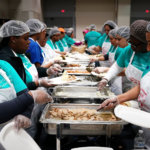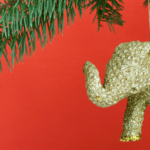A Month of Celebrations
Humans have held celebrations around the Winter Solstice (in the northern hemisphere) for thousands of years. While some traditions, such as Roman Saturnalia, have phased out, others have evolved and grown. Many of these festivals bring light and warmth to the darkest days and nights of the year, while other celebrations anticipate rebirth in the Spring. Let’s look at the most celebrated month on the calendar.
Feast of St. Nicholas: December 5/6
The inspiration for Jolly ol’ St. Nick is none other than St. Nicholas of Myra. It is St. Nicholas who began the tradition of distributing gifts. Although our current traditions include leaving snacks (don’t forget carrots for the reindeer) out on Christmas Eve for Santa Claus, Western Christian countries celebrate St. Nicholas’ Feast on December 5th or 6th, while Eastern Christian countries observe the holiday on December 19.
Bodhi Day: December 8
Buddhists celebrate the day that Siddhartha Gautama—known as Buddha—experienced enlightenment while he sat beneath a Bodhi tree. After meditating under the tree, he was “awakened” to the eightfold path and four noble truths, which are the core of Buddhist teachings. Buddhists celebrate the day with meditation, a traditional meal of cake and tea, reading the sutras, and performing acts of service and kindness toward other beings.
Las Posadas: December 16-24
This tradition is celebrated throughout Latin America. It re-enacts the travels of Mary and Joseph to Bethlehem. Houses are designated as inns, and Maria y José travel from house to house over nine evenings. At each home, there is prayer and singing: at the end of the evening, there is a feast, and children break a star-shaped piñata.
Hanukkah
One of the world’s most honored holidays, Hanukkah begins on the 25th day of Kislev on the Hebrew calendar (this date falls between late November and late December on the Gregorian calendar). The celebration lasts for eight nights and days and commemorates the Second Temple’s rededication at the start of the Maccabean revolt. As part of the dedication, a menorah was lit. Although there was only enough of the sacred oil for one night, the menorah miraculously burned for eight days.
Today, the holiday—also known as the Festival of Lights—is celebrated by lighting the shamash candle, which, in turn, is used to light a candle on the menorah on each night of Hanukkah. On each night of Hanukkah, gifts are exchanged, blessings are recited, and there are songs and games. Oil- and dairy-based foods are traditionally consumed, including latkes (potato pancakes) and sufganiyot (jam-filled doughnuts).
Yalda: December 21-22
Corresponding to the longest and darkest night of the year, Yalda falls on the night between Azar, the last day of the ninth month, and Dey, the first day of the tenth month on the Iranian calendar. Rooted in the Zoroastrian tradition, Yalda celebrates the victory of light over dark and good over evil as symbolized by Mithra, who was born at dawn on December 22nd. Persians commemorate the holiday by practicing Shab Chera (“night gazing”), staying up all night. Traditional Yalda foods include nuts and fruit such as pomegranate, as its color symbolizes Mithra and the skies at dawn.
Yule: December 22
Most of the current traditions we associate with Christmas are borrowed from the Winter Solstice celebration known as Yule. This pre-Christian tradition was held on the longest night of the year with feasts as well as lights and fires to symbolize the anticipated return of the sun—and the renewed life its light and warmth bring—in the coming weeks. Other ancient traditions associated with the celebration include caroling, gift exchanging, burning a Yule log, decorating trees, and making wreaths from evergreen branches.
Christmas: December 25
December 25th is the day that Christians commemorate the birth of Jesus Christ. In traditional Christian scripture, Jesus was born to Mary and Joseph in a stable in Bethlehem. Today, the holiday has evolved into a global secular celebration. While many traditions, such as large meals, decorations, and gift-giving, are observed throughout the world, there are some differences.
Throughout the northern hemisphere, Christmas is often depicted with snow-covered scenes, candlelight, and warming fires. In the southern hemisphere, Christmas falls during the summer. So, in countries such as Australia, the holiday is often celebrated with campouts and beach parties. Instead of decorating evergreen trees, they decorate the Christmas Bush that has small green leaves and red flowers.
Boxing Day: December 26
This holiday has nothing to do with the sport, not even in America where day-after-Christmas sales and gift returns often turn into full-contact competitions.
The Boxing Day tradition is celebrated in a handful of countries, mostly within the British Empire. Its origins date back to the Middle Ages when the collection boxes (known as “alms” boxes) were opened. Their contents were distributed to the poor. In wealthy families, Boxing Day was also a day where servants were given the day off to celebrate Christmas with their own families.
Contemporary observances of the holiday include horse racing and football (soccer) matches throughout the United Kingdom. In the Bahamas, the day is celebrated with Junkanoo, a popular festival and street parade.
Kwanzaa: December 26 – January 1
In the aftermath of the Watts riots in Los Angeles, California, in 1965, Dr. Maulana Karenga created a holiday for Black people to celebrate their culture and history as an alternative to Christmas. First observed in 1966, Kwanzaa is derived from the Swahili phrase matunda ya kwanza, which means “first fruits.”
The holiday is celebrated over seven days, each day dedicated to one of the seven principles of Kwanzaa. A candle is lit for each day of the holiday and is held in a Kinara. The celebrations also include storytelling, dances, songs, African drums, and concludes with a large feast known as Karamu Ya Imani.
New Year’s Eve: December 31
The final night on the Gregorian calendar is celebrated all over the world. While many of the night’s festivities are common, including gatherings with singing, fireworks, and cheering the new year, many countries have traditions specific to their culture.
In Japan, for instance, Ōmisoka is considered one of the most important holidays on the Japanese calendar. Families gather to share bowls of noodles, symbolizing crossing from one year to the next, and many people visit shrines or temples.
A Month Rich with Tradition
Have you discovered traditions here that you want to integrate into your family’s observances? With holidays and observances nearly every day, December feels like a month-long festival that celebrates the best of the human spirit.
This post may contain affiliate links. Meaning a commission is given should you decide to make a purchase through these links, at no cost to you. All products shown are researched and tested to give an accurate review for you.




